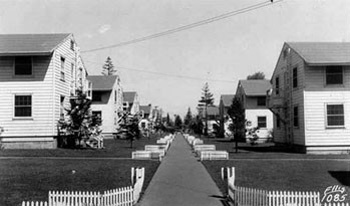
Casey McNerthney's article "Book provided evidence for exonerating Fort Lawton veterans" on 18 August 2011 published in the Seattle PI states: For decades, the late Samuel Snow said he didn't think the world would ever know the truth.
At 19, he was convicted of rioting at Magnolia's Fort Lawton on a night that led to an Italian POW's death. He left Seattle in handcuffs, dishonorably discharged from the Army, and spent years as a working poor janitor in a segregated Florida town.

Many people, including dozens of reporters, who covered Snow and the other 27 men convicted in the largest and longest court-martial of World War II, accepted the nearly forgotten verdict.
And then, a Seattle man found evidence that changed history.
"Wouldn't have made it without Jack," Snow told the P-I last year. "He believed."
Jack Hamann wrote "On American Soil," the book that detailed evidence that a white military policeman lynched the POW and blamed the death on black soldiers who weren't even there.
The work, named Book of the Year Award by Investigative Reporters & Editors, caught the attention of Rep Jim McDermott, D-Seattle, who introduced a bill demanding that the Army reopen the Fort Lawton case. They found prosecutor Leon Jaworski – the man who would later become famous as the Watergate special prosecutor – committed an "egregious error" by intentionally withholding exculpatory evidence.
On Saturday, a top Army official gave families of the wrongly convicted plaques affirming their honorable discharge. And he offered words most of those convicted never lived to hear: "We're sorry."
Snow's son, Ray, said this weekend he found a new family – ones found because of dedicated investigative journalism.
"What they have done for all of us, we can barely put into words," said Lashell Drake, a Milwaukee, Wis., woman whose late grandfather, Booker Townsell, was wrongly convicted. "They filled in the blanks to what none of us knew about our family members."

The investigation started in 1986 when Hamann was a young reporter for KING/5. He was assigned to cover a routine press conference on proposed expansion of a sewage treatment plant at Discovery Park, which was once all an enormous Army Fort.
Hamann stood in the back, bored out of his mind.
There really are some cool things at the fort, a spokeswoman told him. There are trails, the beach, a military graveyard. And one of the graves was a mysterious broken column, with an inscription possibly in Latin, she said.
Hamann went there and found an Italian man's name – Pvt. Guglielmo Olivotto – with his date of death. Microfilm research at the downtown Seattle library led him to a banner P-I headline about a riot and murder at Fort Lawton. Like most people in Seattle, he'd never heard the story.

With the support of an assignment editor, Hamann cranked through easy morning assignments and spent afternoons trying to find anything he could about the case. Some days, he'd just go to the gravestone, hoping someone who knew something would wander by.
The following year, Hamann produced an hour-long documentary for KING/5 based on secondary sources, offering no substantial evidence to refute Jaworski's case.
The program won a local Emmy, drew praise from across the nation. But as Hamann now admits, "It was a lie."
Not an intentional lie, he said, but one created because – like other reporters – he didn't find enough primary sources.
More than a decade later, after his son and daughter moved to college from their Queen Anne home, Hamann – still moved by what he'd heard from four of those convicted – had more time to spend on the case.

As part of a four-year research effort, Hamann and his wife, Leslie, took two trips to the National Archives in College Park, Md.. They'd heard an inspector general had completed a report before the 1944 trial with evidence proving the 28 convicted men were innocent.
They searched files World War II courts martial. Nothing.
They searched folders on Fort Lawton. Nothing.
They turned to miscellaneous Army files from World War II – a section that had millions of documents. Some days they started there with venti drip coffees at 9 a.m. and didn't leave until 10 p.m.
After nearly a month of digging in 2002, Leslie Hamann grabbed her husband's arm.
"Jack," she said, "Look at this."
The report and addendum by Gen. Elliot Cooke – thousands of pages of documents that had recently been declassified – showed that Fort Lawton commander Col. Harry Branson had botched the initial criminal investigation. It gave the evidence Jaworski had access to and didn't reveal.
Within days of getting the book, McDermott discussed introducing legislation that would make the Army reopen the case. But McDermott, a well-known liberal, was expected to get opposition from across party lines.
"We thought it was nice," Jack Hamann said. "But we told all of our friends that's as far as it goes."
After a House Armed Services Committee vetted the book, McDermott and Republican Rep. Duncan Hunter agreed to exercise a congressional privilege allowing them to insist that the Army Board for Correction of Military Records review the convictions.
Last fall, that board overturned the verdicts.
That brought about change the Hamanns – who say they were just doing their job – didn't expect when they started the project. Many family members said they never thought it would come.
"We started out just curious why such a monumental event in Seattle's history wasn't given proper treatment," Jack Hamann said. "The real honest truth is we did what every good reporter wants the chance to do." (source: Seattle PI)
No comments:
Post a Comment